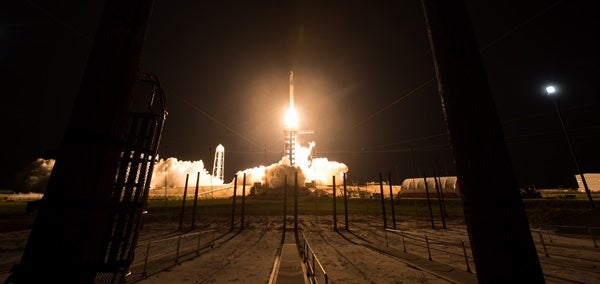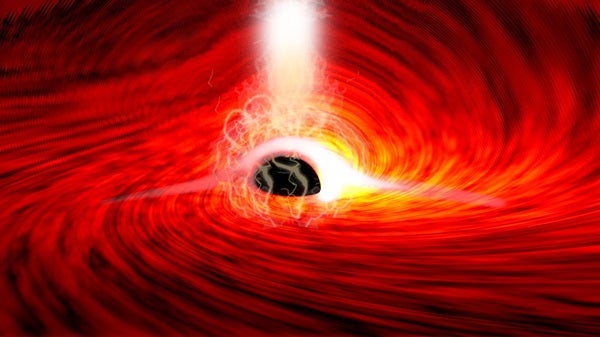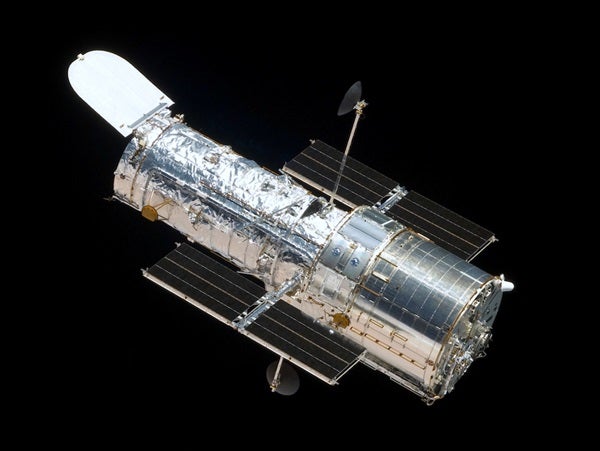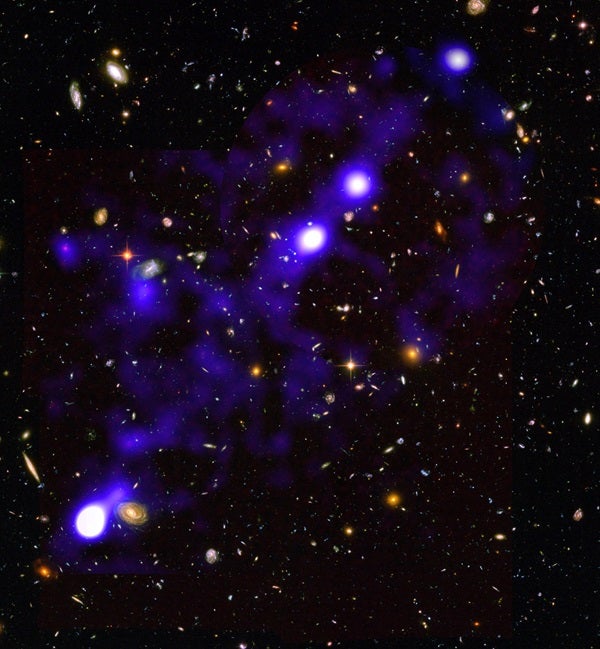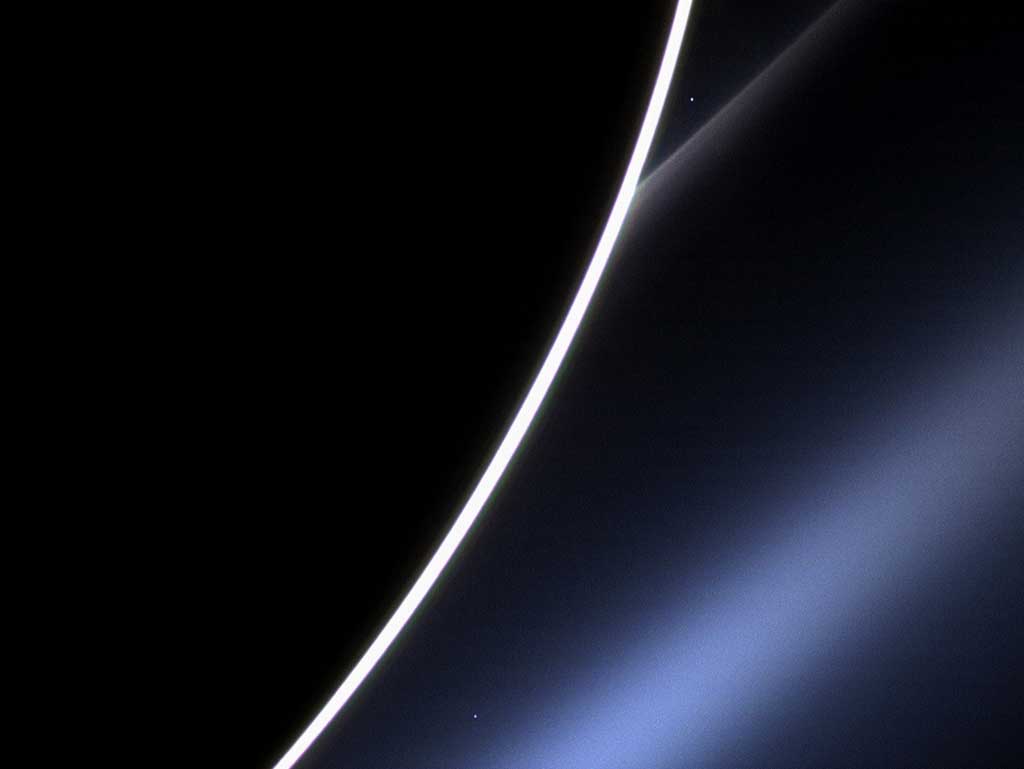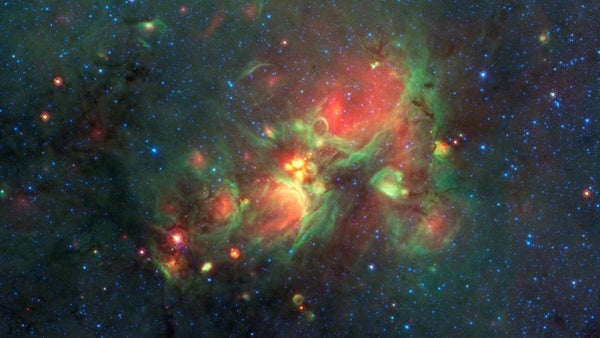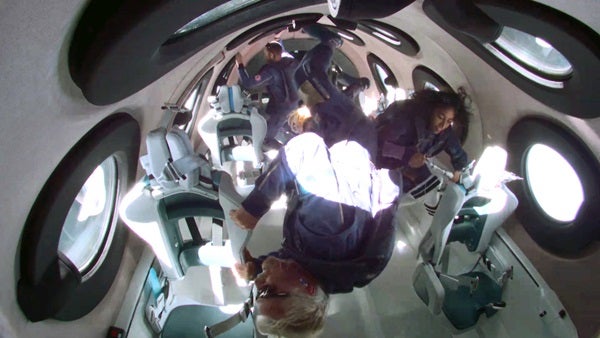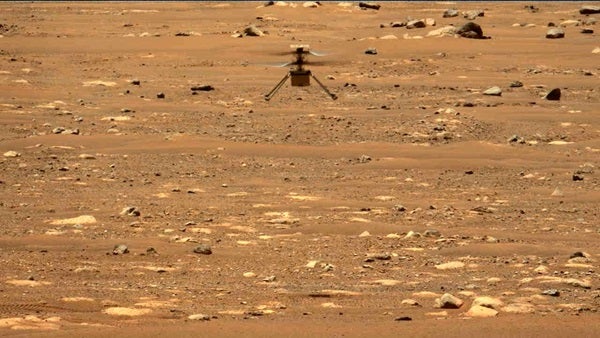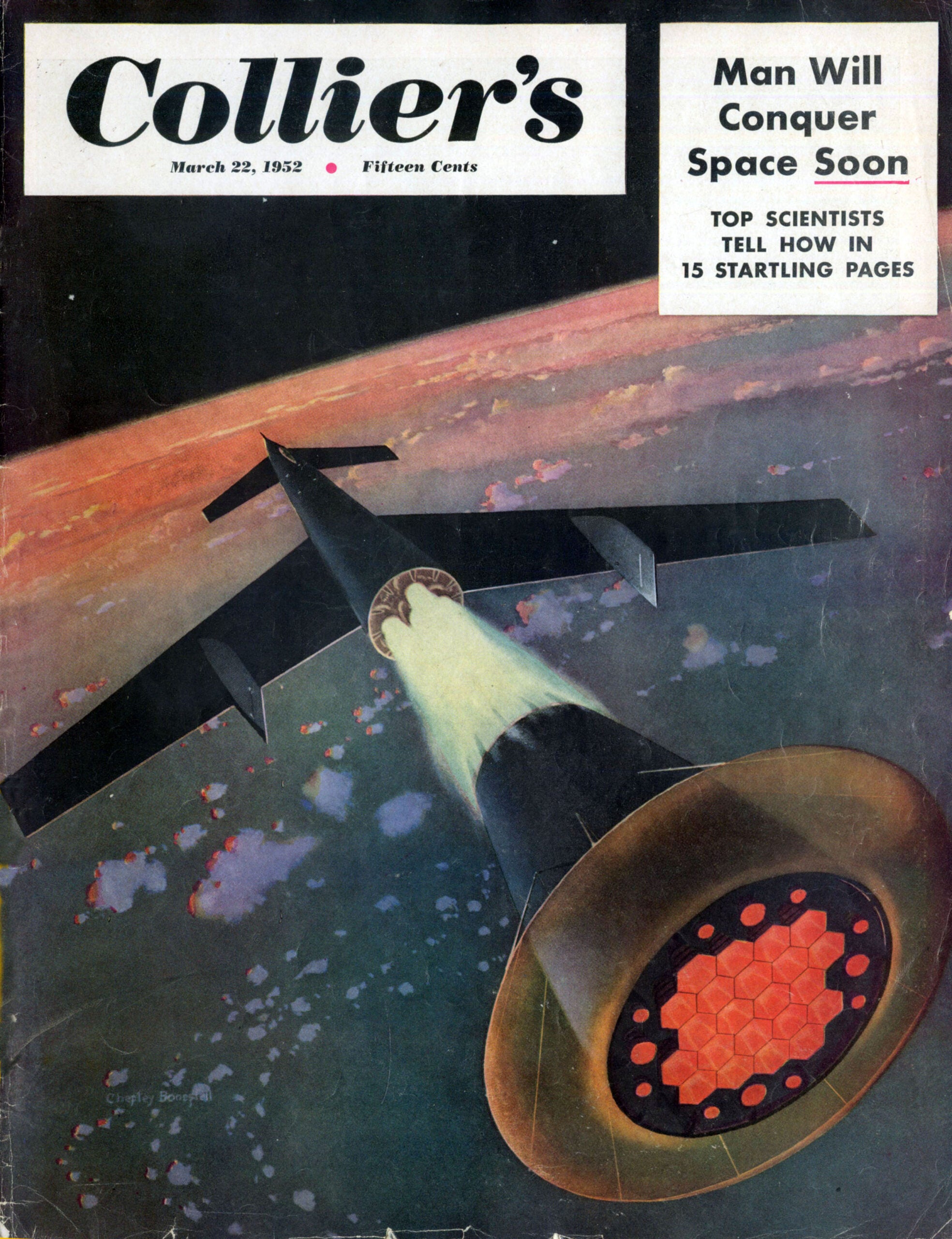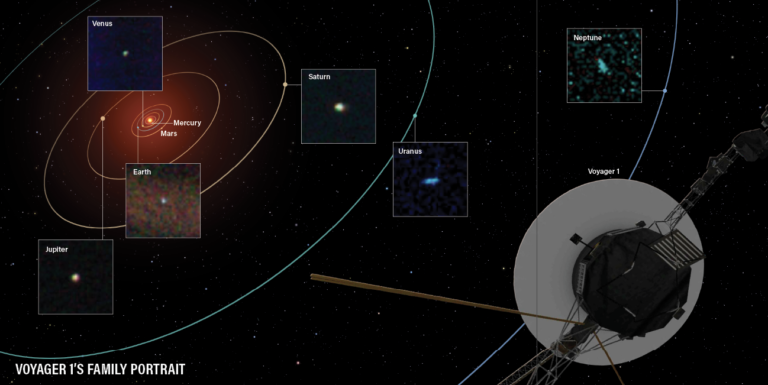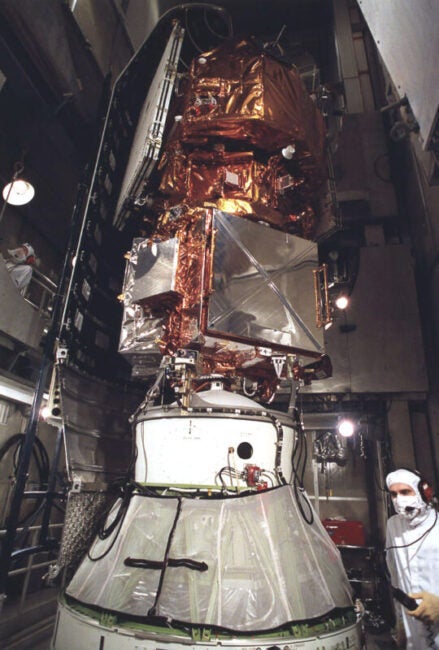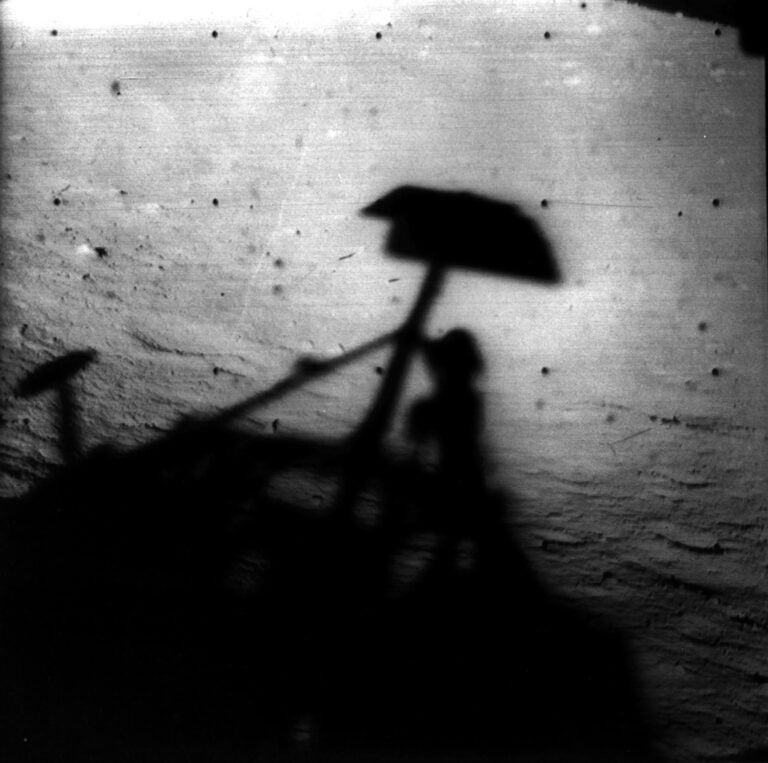Following in the wake of an unprecedented year, 2021 was certainly filled with ups and downs. The global COVID-19 pandemic continued to challenge the way we do science, even prompting some positive changes that may be here to stay. Astronomers lost a beloved workhorse observatory, but rescued another from the clutches of a computer glitch. The three robotic missions that launched to Mars in 2020 arrived at their destination, kicking off a flurry of exciting firsts. And now, space agencies have chosen another three missions to visit a different neighbor: Venus.
Commercial spaceflight companies SpaceX, Virgin Galactic, and Blue Origin continued to turn heads, while China’s space program really picked up. And astronomers have finally laid eyes on several phenomena either long theorized or rarely glimpsed before, deepening our understanding of the universe around us.
In all, 2021 brought us new viewpoints and new goals that will pepper these pages for years to come.
10. OSIRIS-REx heads home
NASA’s Origins, Spectral Interpretation, Resource Identification, Security-Regolith Explorer (OSIRIS-REx) mission is finally on its way home. On May 10, the spacecraft fired its engines, breaking from orbit around the near-Earth asteroid Bennu — its home since arriving Dec. 31, 2018. Locked inside the spacecraft’s Sample Return Capsule (SRC) is the mission’s sample collector head, which on Oct. 20, 2020, gathered an estimated 14.1 ounces (400 grams) of material from the asteroid’s surface during a six-second-long touch-and-go sample collection procedure.
In fact, the sample head snagged such a large haul that subsequent photos from the spacecraft showed some of the collected regolith had wedged open a flap meant to seal it inside. The photos prompted mission controllers to stow the head inside the spacecraft in late October, to prevent too many sample particles from floating away, rather than waiting until early November as originally planned.
Now, its package safely stored, OSIRIS-REx is headed for Earth and will fly past our planet on Sept. 24, 2023. That’s when it will release the SRC to parachute to the ground while the spacecraft continues onward, ultimately to orbit the Sun between Venus and Mercury. If approved, a suggested mission extension could later send the craft on to visit 99942 Apophis in 2029.
The mission follows in the footsteps of the Japan Aerospace Exploration Agency’s Hayabusa2, which in February 2019 collected samples of another near-Earth asteroid, Ryugu, returning them to Earth Dec. 6, 2020. Like OSIRIS-REx, Hayabusa2 performed a flyby of our planet. It is now headed to visit two more near-Earth asteroids: (98943) 2001 CC21 and 1998 KY26. NASA received and is currently studying a portion of Ryugu’s soil in exchange for sharing a sample from Bennu.
9. Scientists take a peek behind a black hole
Einstein’s theory of general relativity has been confirmed several times in recent years. And last year, it was reinforced yet again, with the first observation of X-rays coming from behind a black hole, bent in our direction as the black hole’s gravity warps the shape of space-time around it.
Although light cannot escape from inside a black hole’s event horizon, we can see signals emitted from outside this boundary, where a superheated, fast-moving accretion disk of material swirls inward. This is the region astronomers were looking at within the heart of galaxy I Zwicky 1, located 800 million light-years away, using two X-ray space telescopes: NASA’s NuStar and the European Space Agency’s XMM-Newton. There, they were watching the super-massive black hole for bright flares of X-ray light from its corona — a spherical region of energetic particles around the black hole.
But a short time after each flare, the telescopes recorded a fainter X-ray flash at a different wavelength. These flashes, the team determined, were the echoes of each flare reflecting off the portion of the accretion disk blocked from us by the black hole’s shadow. The change in wavelength of the light indicated the reflections had been twisted and stretched by gravity, until they’d arced around the black hole and back toward Earth.
It is the first time such behavior, long predicted by general relativity, has been directly observed. “We think that anytime we’ve seen these reflections coming from the accretion disk, there should be some part of that signal that is coming from behind the black hole, but it’s not been possible to separate it out,” says Dan Wilkins of Stanford University, lead author of a paper published July 28 in Nature describing the observations. “Now we’ve been able to actually tease out that signal.”
Seeing that signal gives astronomers one more peek into how black holes truly work. Most of these extreme objects cannot be imaged directly, so the trick is working out ways to see them without actually seeing them. And that’s where this new find fits in: X-ray flares provide key information about the region immediately around the black hole, Wilkins says. “What we’re hoping is that we’ll be able to take what we’ve learned and use this to actually be able to reconstruct an image of other black holes right across the universe.”
8. The Hubble Space Telescope hiccups
Even after nearly 32 years, the Hubble Space Telescope (HST) remains one of astronomy’s workhorses. But with hard work comes wear and tear. And with the space shuttle retired, there is no way to physically repair the aging space telescope. Instead, NASA relies on remotely diagnosing issues and developing workarounds based on the equipment currently installed on the orbiting observatory, much of which is original hardware built in the 1980s.
Around 4 P.M. EDT on June 13, Hubble’s payload computer, which manages the onboard suite of instruments, stopped working. In response, the telescope’s main computer placed the science instruments into safe mode, halting observations. A June 14 reboot of the payload computer failed to solve the issue, leading to nearly a month of careful testing to determine and resolve the problem that had crippled the observatory.
On June 23 and 24, in an attempt to bypass what engineers believed was a problem due to aging hardware, controllers turned on HST’s backup payload computer, which had never been activated in space. But this failed to solve the issue. So, the team moved on to different solutions, including switching to the telescope’s backup Science Instrument and Command & Data Handling (SI C&DH) unit, a process that required meticulous programming from the ground to turn on several more system backups that had also never before been used in space.
A team of more than 50 people — including HST alumni who had moved on to other projects or retired — worked for two weeks to outline, simulate, and approve this switchover procedure. At the same time, engineers finally determined the real culprit: Hubble’s Power Control Unit (PCU), which regulates energy throughout the telescope, including to the payload computer. Fortunately, HST’s backup SI C&DH unit also houses a backup PCU. The team initiated the switchover on July 15, successfully completing the procedure by 11:30 P.M. EDT that night.
Two days later, NASA announced Hubble had returned to operational status following the successful switch to backup hardware. On July 19, the agency released the first images taken since the shutdown, proving the telescope was back up and running at full capacity.
But the telescope’s instruments again briefly entered safe mode Oct. 25, following two days of error messages indicating issues with HST’s ability to correctly time commands and responses. By Nov. 7, engineers had restored the Advanced Camera for Surveys, while the remaining instruments were kept in safe mode until the error’s origin had been uncovered.
Despite these bumps, HST’s unparalleled capabilities mean mission teams will continue to maintain the prestigious observatory as long as its components — and funding — last.
7. The cosmic web shows off its glow
The cosmic web is a vast network of filaments of dark matter and normal matter (stars and gas) strung through the universe like a spiderweb. Galaxies lie along these filaments, with larger groups and clusters of galaxies congregating where filaments cross and intersect.
Although it is all around us, this cosmic web is notoriously difficult to observe. Astronomers can only see it when hydrogen gas, either inside or outside galaxies strung along these filaments, glows. But this hydrogen needs something to light it up: either a galaxy’s stars from within, or a bright light source such as a quasar or galaxy cluster shining on it from the outside. Researchers have seen the latter — but these are rare, specific cases, and seeing only unique circumstances limits our understanding of the universe as a whole.
This sparse picture is now beginning to change. A paper published March 18 in Astronomy & Astrophysics highlights a new image of the cosmic web. Taken by staring at a single region of the sky for 140 hours over a period of eight months, the groundbreaking shot was captured with the Multi Unit Spectroscopic Explorer (MUSE) on the European Southern Observatory’s Very Large Telescope in Chile. After a full year of data processing, the resulting image reveals light from hydrogen strung along filaments of the cosmic web as they appeared 10 billion to 12 billion years ago.
In all, the image shows five filaments at different distances, says study co-author Thibault Garel at the University of Geneva. These filaments are glowing because, embedded within each structure, he says, are thousands of small, faint galaxies. These galaxies are too small to spot individually, but together, light from hydrogen within them combines to create the filamentary glow seen in the image.
Says Garel, “Our study can be seen as the first detection of the cosmic web in typical filamentary environments” — rather than in the special conditions under which it’s been spotted before. And the myriad small, faint galaxies lighting up the web in the MUSE image had gone previously undetected. Their presence, Garel says, “has strong implications for our understanding of the formation of galaxies in the universe.” Specifically, he says, it implies that all the bright, massive galaxies we easily observe “are just the tip of the iceberg and that many more much smaller objects do exist.”
Now, the team plans to use state-of-the-art cosmological simulations to learn more about the newly discovered population of small galaxies by trying to recreate the light they produce. Further down the road, Garel adds, the team hopes to repeat or even improve on the image, potentially with a next-generation instrument called BlueMUSE, which could detect the cosmic web over an even larger part of the sky.
6. We set our sights on Venus
Venus is already the hottest destination in the solar system — literally, with surface temperatures up to 890 degrees Fahrenheit (470 degrees Celsius). But now it’s also figuratively the hottest destination: In 2021, NASA and the European Space Agency (ESA) selected three new missions aimed at Earth’s sister planet.
On June 2, NASA announced it would send two spacecraft to Venus by 2030: VERITAS, short for Venus Emissivity, Radio Science, InSAR, Topography & Spectroscopy; and DAVINCI, short for Deep Atmosphere Venus Investigation of Noble gases, Chemistry, and Imaging. Eight days later, ESA announced its EnVision mission will launch for Venus in the early 2030s.
The DAVINCI orbiter will combine flybys of the planet with an orbiter that will drop the first probe sent into the venusian atmosphere by the U.S. since 1978. This spherical probe will sample the chemistry of the planet’s thick, forbidding atmosphere hundreds of times as it passes through each layer during an hour-long descent. “Our approach is to target that big atmosphere as a wondrous chemical laboratory of environments and histories that we can read in the record of the chemistry,” says DAVINCI principal investigator James Garvin of NASA’s Goddard Space Flight Center. The probe will also snap images as it falls, providing the highest-resolution views yet of its mountainous landing site, called Alpha Regio, from beneath Venus’ thick cloud cover.
Meanwhile, the VERITAS orbiter will use radar to pierce Venus’ obscuring clouds and map the entire surface in 3D — the first comprehensive look at that surface since NASA’s Magellan mission ended in 1994. Near-infrared sensors will allow researchers to determine important planetary properties, such as surface composition, gravitational field strength, and interior structure. VERITAS will also look for signs of recent volcanic activity and other geologic processes. Its goal is to uncover clues about Venus’ geological past and present, revealing how the planet became the forbidding landscape it is today.
Finally, the EnVision orbiter is an ESA-led collaboration with NASA to globally study Venus in exquisite detail. Its suite of instruments includes spectrometers to measure atmospheric composition, a sounder to probe the planet’s interior, radar to map the surface in high resolution, and a radio tracker to study a broad range of characteristics, from the planet’s gravity field and interior to the structure of its atmosphere.
Because Venus is so similar to our home planet in size, mass, and composition, there is much it can tell us about how nearly identical planets can evolve so differently, even in the same system. Furthermore, Garvin says, the lessons we learn there can be applied to Venus-like extrasolar planets, which current and upcoming exoplanet surveys are expected to find in spades.
But despite its proximity to Earth, Venus is vastly understudied compared to our other planetary neighbor, Mars. The Magellan data are now decades old, which means that in terms of understanding Venus, “where we are today is this huge opportunity staring at us — a lost frontier that we can now rediscover,” says Garvin. These three new missions will perfectly complement one another, together painting the clearest picture we’ve ever had of the mysterious planet next door.
5. Citizen scientists aid major discoveries
Citizen science allows anyone — of any age and from anywhere on the planet — to participate in meaningful scientific discovery. Platforms such as Zooniverse have encouraged researchers in astronomy and other fields to invite the public to take part in a wide array of accessible, engaging projects.
In 2021, Zooniverse projects were seeing roughly two to three times their pre-pandemic participation rates, says Laura Trouille, vice president of citizen science at Chicago’s Adler Planetarium. During a single week in August, roughly 100,000 people contributed millions of classifications across Zooniverse’s 89 active projects, which Trouille says is “the equivalent of 20 years of full-time research in just one week. That’s the power of the crowd; each person doing a little bit, leading to a huge impact!”
By early September, data from Zooniverse projects had been included in over two dozen peer-reviewed papers, including 13 in astronomical journals.• On Jan. 21, the SuperWASP Variable Stars project published its first results on variable stars in Monthly Notices of the Royal Astronomical Society. Their findings were drawn from more than 1 million classifications from citizen scientists and included 301 previously unknown variable stars and binary systems.
• A Feb. 23 paper in The Astrophysical Journal Supplement Series included work from Zooniverse’s Backyard Worlds: Planet 9 project to create the most detailed map to date of brown dwarfs — failed stars too small to fuse hydrogen in their cores — within 65 light-years of Earth.
• A second paper from Backyard Worlds, published July 15 in the Astrophysical Journal, highlights three volunteer-discovered brown dwarfs of a rare type called extreme T-subdwarfs — extremely old, cold brown dwarfs. Astronomers previously only knew of two other extreme T-subdwarfs — also discovered by Backyard Worlds volunteers.
• An April 13 Astrophysical Journal study found that most yellowballs — small, round regions of dust around clusters of newly formed stars — house stars so young they are still pulling in gas from their surroundings. Yellowballs were initially discovered by participants in Zooniverse’s Milky Way Project, and so named because their light takes on a yellow hue in the false-color scheme of infrared images. They are often missed in other surveys searching for more massive young or actively forming stars.
• An April 8 paper in the Astronomical Journal confirmed volunteers’ findings of a sixth planet around the star K2-138. The system’s five other planets were also discovered by participants in the same Zooniverse project, Exoplanet Explorers.
• A May 12 paper in Monthly Notices of the Royal Astronomical Society announced the discovery of two planets the size of Neptune and Saturn circling the Sun-like star HD 152843. Sixteen volunteers whose work in the Planet Hunters TESS (the acronym for NASA’s Transiting Exoplanet Survey Satellite) project led most directly to the discovery were listed as co-authors.
The coronavirus continues to impact science
The COVID-19 pandemic continued to shape science in 2021, as measures quickly put in place in 2020 to maintain safe social interactions remained. Major academic meetings stayed virtual, as did most NASA proceedings, including mission proposal presentations. Many astronomy clubs continued to offer online events and talks, often allowing them to reach larger audiences and bring in faraway speakers with no need for travel. Citizen science platforms such as Zooniverse, SciStarter, and the Unistellar Network continued to see high levels of participation as teachers, students, and other enthusiasts searched for or shared ways to engage with astronomy remotely.
Scientific research marched onward: Observatories that closed in 2020 had largely reopened, generally with reduced staff and queue observing. But while the pandemic clearly spurred innovation and new ways to connect, it also took its toll on some of the best-laid plans. The Vera C. Rubin Observatory, slated to see engineering first light in 2021, pushed this milestone back a year. It is now expecting its camera to see engineering first light in October 2022 and start science operations no earlier than a year later.
Several space missions remained delayed, including the Indian Space Research Organisation’s Chandrayaan-3 Moon mission, now expected to launch in 2022. The continuing need for liquid oxygen to support COVID-19 patients disrupted supply chains and caused NASA to push back the Sept. 16 launch of its Landsat 9 satellite by a week. According to a briefing, the launch required liquid nitrogen — but necessary deliveries of liquid oxygen to hospitals meant no trucks were available to carry liquid nitrogen to the launch site. And a NASA report stated the pandemic had caused several mission launch dates to slip between one and 10 months, estimating that delays and other challenges related to the pandemic could ultimately cost the agency some $3 billion USD.
4. Astronomers spot a new type of supernova
Astronomers have long that stars more massive than about eight Suns die in powerful blasts, known as type II or core-collapse supernovae. But in 1980, a paper in Publications of the Astronomical Society of Japan suggested that stars in a specific mass range — eight to 10 times the mass of the Sun — would die in a unique explosion called an electron-capture supernova. Prior to such a star’s death, its core is supported by electron degeneracy pressure, generated in dense environments where physics prevents free electrons from getting too close. But as magnesium and neon atoms in the core absorb (i.e., capture) these free-floating electrons, the pressure drops and the star’s inner regions collapse into a neutron star as the outer regions rebound as a supernova.
While some supernovae have exhibited hints they could be an electron-capture supernova, none exactly matched the theory. Until March 2018, that is, when Japanese amateur astronomer Koichi Itagaki spotted a supernova in the galaxy NGC 2146, which lies about 31 million light-years away. Researchers raced to image the explosion, called SN 2018zd, with the Hubble Space Telescope. Comparing their data with previous Hubble images of the galaxy, they identified the progenitor star. And after fully analyzing the star and its explosion, the team published a paper June 28 in Nature Astronomy announcing it neatly fits all six expected criteria for an electron-capture supernova.
“We started by asking, ‘What’s this weirdo?’ Then we examined every aspect of SN 2018zd and realized that all of them can be explained in the electron-capture scenario,” said the study’s lead author, Daichi Hiramatsu at the University of California, Santa Barbara, and Las Cumbres Observatory, in a press release. “It was such a ‘eureka moment’ for all of us that we can contribute to closing the 40-year-old theoretical loop.”
The progenitor was the specific mass and type of red giant theorized to produce an electron-capture supernova, and the density and composition of its stellar winds prior to its demise also matched expectations. The explosion itself — its light lingering as the shock wave hit material the star had sloughed off before its death — behaved exactly as astronomers modeled for this type of stellar blast. Finally, the particular chemical fingerprints of the debris matched calculations of what an electron-capture supernova leaves behind.
Now, researchers can slot this information into the bigger picture of how stars live and die. The masses of stars that create electron-capture supernovae fit neatly between stars that leave behind a white dwarf, like the Sun, and those that explode in a core-collapse supernova. “One of the main questions in astronomy is to compare how stars evolve and how they die,” said study co-author Stefano Valenti at the University of California, Davis. “There are many links still missing, so this is very exciting.”
Connections to the Past
The discovery of a new type of supernova may also solve a centuries-old mystery. Researchers have long believed the supernova of A.D. 1054, which produced the famous Crab Nebula (M1), was an electron-capture supernova. Despite the fact that it popped off long before astronomers had instruments such as telescopes and spectrometers to chart the skies, this blast was previously the best-fitting example of such an event. From the neutron star it left behind to the way ancient astronomers recorded its light changing after the initial blast to modern observations of how the nebula has slowly expanded over time, the Crab meets several criteria for this particular flavor of supernova. Now, SN 2018zd provides firm evidence linking M1 to an electron-capture supernova — and that gives researchers a current picture of how these events evolve in the centuries after they explode.
3. The commercial spaceflight scene heats up
On May 30, 2020, two astronauts launched to the International Space Station (ISS) aboard SpaceX’s Crew Dragon capsule. Since then, crewed trips via SpaceX’s craft have become routine. In 2020 and 2021, the company sent three crews and a total of 12 more astronauts to the ISS, successfully reusing a Falcon 9 rocket and Crew Dragon capsule to do so. Crew Dragon has now firmly reestablished NASA’s ability to put people in orbit without relying on its Russian partners.
And NASA seems keen to expand its relationship with SpaceX. On April 16, the agency announced its selection of SpaceX’s Human Landing System (HLS) Starship to return humans to the Moon via the Artemis program. NASA had been widely expected to award contracts to two companies to nurture the growing industry and foster competition. Instead, SpaceX received the sole contract, worth $2.89 billion, beating out its two competitors, Dynetics and Blue Origin, who had also been working with NASA to develop crewed lunar landing craft.
Some didn’t agree with the choice: On Aug. 13, Blue Origin filed a lawsuit in the Court of Federal Claims, suing NASA over its evaluation and choice to award a single company the entire contract. On Aug. 19, NASA paused development of SpaceX’s lander to allow for litigation. The suit came after Blue Origins and Dynetics had filed a formal complaint with the U.S. Government Accountability Office (GAO), with the GAO on July 30 releasing a statement that “NASA did not violate procurement law or regulation” in awarding a single contract to SpaceX, and the agency’s assessment of all three companies’ proposals was fair. And on Nov. 4, the court ruled against Blue Origin and NASA announced it would resume work with SpaceX on the HLS Starship.
Meanwhile, the commercial space race continued to heat up in other ways. On July 11, Virgin Galactic’s VSS Unity carried the company’s founder, Richard Branson, and five others to an altitude of 53 miles (86 kilometers), crossing the threshold previously required to reach space and earn commercial astronaut wings from the U.S. Federal Aviation Administration (FAA). However, that same day, the FAA changed its requirements to receive commercial astronaut wings. The new guidelines added a requirement that crew members perform “activities during flight that were essential to public safety, or contributed to human space flight safety.”
Less than two weeks later, on July 20, Blue Origin’s New Shepard rocket blasted off with four passengers, including company founder and former Amazon CEO Jeff Bezos and Mercury 13 member Wally Funk. They reached an altitude of 66 miles (107 km) — above the 62-mile-high (100 km) Kármán line, internationally recognized as the boundary of space.
Then, late on Sept. 15 Eastern time, the Inspiration4 mission launched four civilians into orbit aboard a SpaceX Crew Dragon capsule. The crew spent three days in space before splashing down in the Atlantic Ocean. Although operated by SpaceX, the mission was funded by Jared Isaacman, CEO of Shift4 Payments.
All three trips are milestones on the path to a bona fide space tourism industry. With so much progress last year and more on the horizon, commercial spaceflight will surely remain an area to watch.
China’s Space Program
Commercial companies weren’t the only ones reaching for the skies. The China National Space Administration (CNSA) also took several major steps forward in terms of human spaceflight last year.
On April 29 Beijing time, CNSA launched the initial component of its first permanent space station, Tiangong. The core capsule, called Tianhe (meaning “harmony of heavens”), will serve as a residence and control center for orbiting astronauts, as well as a scientific laboratory.
But the story didn’t end there. The Long March 5B rocket that lofted the station’s capsule into space fell back to Earth May 9 (also Beijing time) in an uncontrolled reentry, tumbling into the Indian Ocean. Despite the rocket’s harmless demise, the event drew criticism over CNSA’s lack of foreknowledge coupled with the inability to plan where the debris would fall. The single previous flight of a Long March 5B rocket ended with debris reportedly impacting villages in the Ivory Coast in 2020.
Also on April 29, CNSA and Roscosmos released a joint statement “acknowledging mutual interest in the construction of the International Lunar Research Station (ILRS) for the peaceful exploration and use of the Moon.” A document released June 16 gives an initial timeline for construction of the station between 2026 and 2035, with crewed landings beginning in 2036.
On June 17, CNSA’s Shenzhou 12 mission launched, carrying three astronauts to the Tianhe module in China’s seventh crewed spaceflight. During their stay, the crew completed the country’s second-ever spacewalk.
China is expected to maintain its momentum through 2022 as well. Two additional space station modules will complete the Tiangong station this year, while crewed Shenzhou launches are also planned to continue.
2. Arecibo Observatory collapses
On November 19, 2020, the U.S. National Science Foundation (NSF) announced it would decommission the famed Arecibo Observatory in Puerto Rico. The statement came following a three-month period that saw the failure of first an auxiliary cable, then a main support cable, both connecting the telescope’s 900-ton receiving platform to one of three support towers. Engineers had determined repairs could not be made without risking further damage to the telescope or, more importantly, the safety of construction workers and facility staff.
NSF planned to execute a controlled demolition. But the observatory had other ideas. Around 8 A.M. local time Dec. 1, the receiving platform fell nearly 500 feet (152 meters) into the 1,000-foot-wide (305 m) dish below, destroying both with a crash.
“The loss of Arecibo was shocking — there were several virtual online vigils held in mourning by those who worked with the telescope, and for the broader radio astronomy community,” says Yvette Cendes, a postdoctoral researcher and radio astronomer at the Harvard-Smithsonian Center for Astrophysics in Cambridge, Massachusetts.
For 57 years, Arecibo’s huge white dish was an icon amid the lush green jungle. More than that, its scientific legacy stood unmatched. The observatory had several historic notches in its belt, from spotting the first binary pulsar system in 1974 to identifying the first extrasolar planets in 1992. And although Arecibo had in recent years been surpassed in size by the Five-hundred-meter Aperture Spherical radio Telescope (FAST) in China, the newer facility is not a direct replacement. FAST currently lacks Arecibo’s planetary radar capability, which is needed to characterize the size and spin of near-Earth asteroids.
Arecibo was also a vital link in the North American Nanohertz Observatory for Gravitational Waves, or NANOGrav. This network of observatories is searching for gravitational waves by studying how passing ripples in space-time affect the signals Earth receives from pulsars. Although NANOGrav’s ability to detect gravitational waves in the future will certainly diminish without Arecibo’s contributions, researchers do still have a wealth of past observations with the facility they can refer back to, according to the collaboration’s website.
Naturally, researchers are looking to what comes next. On April 1, the National Astronomical Observatories of the Chinese Academy of Sciences opened FAST to the international community, accepting proposals from researchers around the world. Around the same time, “there was a call for white papers on ideas on how to replace Arecibo, and what to do with the site in general,” Cendes says.
1. Mars gets busy
Last year, our top-ranked science story was Mars — specifically, the launch of three new robotic missions bound for the Red Planet. This year, Mars tops the list yet again because now, those launches have come to fruition.
First on the scene was the United Arab Emirates’ al-Amal (Hope) orbiter, the country’s first interplanetary mission. Hope slipped into Mars orbit Feb. 9, making the UAE the fifth country to ever reach the planet. The orbiter is now studying Mars’ thin atmosphere, tracking stats such as temperature, humidity, and dust levels throughout the next martian year, which lasts 687 Earth days.
The very next day, China’s Tianwen-1 mission entered orbit around Mars. Three months later, early on May 15 Beijing time, the orbiter released a capsule containing a lander and rover, Zhurong, bound for the surface. A successful soft landing at Utopia Planitia in Mars’ northern hemisphere made China the third country to land a craft on the planet and the second to deliver a rover. On May 22, the solar-powered rover drove off its platform to begin its planned 90-day search for subsurface water and ice, as well as signs of life. By the end of August, the rover had driven more than 3,490 feet (1,064 meters), having completed all its assigned tasks and exceeding its original mission parameters.
NASA’s Perseverance rover reached Mars last — although it landed before Zhurong — arriving and landing Feb. 18. The car-sized rover touched down in Jezero Crater near an ancient river delta using the same sky crane maneuver as Curiosity in 2012. One of the highly anticipated mission’s first major milestones came two months later. Perseverance carried Ingenuity: a softball-sized, 4-pound (1.8 kilograms) four-bladed helicopter designed to test the feasibility of such craft on the Red Planet, where the atmosphere is less than 1 percent the density of Earth’s. Future drones could scout ahead to show rovers where the most scientifically rewarding — or physically challenging — terrain lies.
Although its success is not linked to the success of the rover mission, the world nonetheless watched with excitement as, on April 19, Ingenuity became the first craft to achieve powered flight on another world. After its first test — which lasted roughly 39 seconds and involved hovering 10 feet (3 m) off the ground — Ingenuity’s trips grew bolder, longer, and more complex. By early November, Ingenuity had successfully completed 15 flights, achieving altitudes up to 39 feet (12 m) and a maximum single flight distance of 2,051 feet (625 m).
Perseverance was busy as well. On April 20, the rover’s Mars Oxygen In-Situ Resource Utilization Experiment, or MOXIE, successfully converted carbon dioxide from the ambient atmosphere into about 0.2 ounce (5 grams) of oxygen. This crucial demonstration lays the groundwork for scaled-up operations that might generate oxygen for astronauts to breathe or power rockets lifting off the surface.
On Aug. 6, Perseverance drilled for its first rock sample, to be stored in a titanium tube for later retrieval and return to Earth — another mission first. As instructed, the rover drilled into the target rock and performed the steps to place the sample into the tube. “We were all starting to get that feeling you can get in this business when a big milestone comes together,” Mars 2020 project manager Jennifer Trosper wrote in a NASA blog on Aug. 19.
But there was a snag: A check to measure the sample’s volume indicated the tube was empty. Further checks that the rover had not dropped the sample outside the tube turned up nothing as well. “The only reasonable interpretation is that the rock fragmented to dust or sand” as the drill spun, wrote Kenneth Farley, a mission project scientist at Caltech, in a subsequent blog.
“The Sampling and Caching System aboard the rover performed as expected. … However, the rock we chose for this first effort did not,” Trosper concluded. The team determined the consistency of the rock was simply too brittle to withstand drilling and moved on, targeting more promising rocks nearby. And on Sept. 2, NASA announced Perseverance’s second sample collection attempt appeared successful. By Sept. 6, the rover had confirmed the sample’s presence, sealed the container, and stored the tube for later drop-off with other samples.
Perseverance will continue exploring its landing site for several hundred days, traveling up to 3 miles (5 km) and caching up to eight samples. It will then set off for the river delta to search for signs of ancient life.
Stories to Watch for in 2022
- Several Moon-bound missions will launch in 2022, including the Japanese Space Agency’s first lunar lander, Smart Lander for Investigating Moon (SLIM); Roscosmos’ Luna-25 lander; South Korea’s first lunar mission, Korea Pathfinder Lunar Orbiter (KPLO); and NASA’s Intuitive Machines 1 (IM-1), Polar Resources Ice Mining Experiment-1 (PRIME-1), Peregrine Mission 1, and XL-1 Lander missions.
- The ESA’s JUpiter ICy moons Explorer (JUICE) mission, which will study Ganymede, Europa, and Callisto, will launch for the solar system’s largest planet in June 2022.
- NASA’s Psyche mission to the metallic main-belt asteroid 16 Psyche is scheduled to launch in August 2022. It will carry a secondary mission, Janus, comprising two small spacecraft that will visit the binary asteroids (175706) 1996 FG3 and (35107) 1991 VH.
- The ESA/NASA Solar Orbiter makes its third flyby of Venus on Sept. 3, 2022. Its next close encounter with the Sun — the first since beginning its main science operations — occurs this year as well, bringing the craft within about 30 million miles (48 million kilometers) of our star.
- The 12-day launch window for ExoMars 2022, which combines a Russian lander with an ESA rover, opens Sept. 20, 2022. Once launched, the pair will reach Mars in early to mid-2023.

